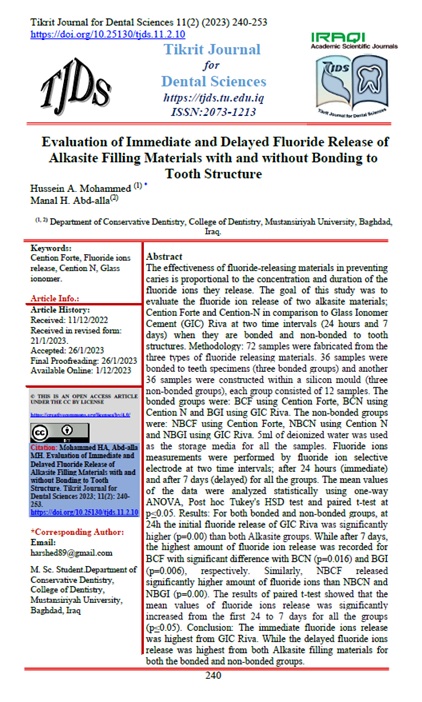Evaluation of Immediate and Delayed Fluoride Release of Alkasite Filling Materials with and without Bonding to Tooth Structure
Hussein A. Mohammed
Department of Conservative Dentistry, College of Dentistry, Mustansiriyah University, Baghdad, Iraq.
Manal H. Abd-alla
Department of Conservative Dentistry, College of Dentistry, Mustansiriyah University, Baghdad, Iraq.
DOI: https://doi.org/10.25130/tjds.11.2.10
Keywords: Cention Forte, Fluoride ions release, Cention N, Glass ionomer
Abstract
The effectiveness of fluoride-releasing materials in preventing caries is proportional to the concentration and duration of the fluoride ions they release. The goal of this study was to evaluate the fluoride ion release of two alkasite materials; Cention Forte and Cention-N in comparison to Glass Ionomer Cement (GIC) R iva at two time intervals (24 hours and 7 days) when they are bonded and non-bonded to tooth structures. Methodology: 72 samples were fabricated from the three types of fluoride releasing materials. 36 samples were bonded to teeth specimens (three bonded groups) and another 36 samples were constructed within a silicon mould (three non-bonded groups), each group consisted of 12 samples. The bonded groups were: BCF using Cention Forte, BCN using Cention N and BGI using GIC Riva. The non-bonded groups were: NBCF using Cention Forte, NBCN using Cention N and NBGI using GIC Riva. 5ml of deionized water was used as the storage medi a for all the samples. Fluoride ions measurements were performed by fluoride ion selective electrode at two time intervals; after 24 hours (immediate) and after 7 days (delayed) for all the groups. The mean values of the data were analyzed statistically using one-way ANOVA, Post hoc Tukey's HSD test and paired t-test at p≤0.05. Results: For both bonded and non-bonded groups, at 24h the initial fluoride release of GIC Riva was significantly higher (p=0.00) than both Alkasite groups. While after 7 days, the highest amount of fluoride ion release was recorded for BCF with significant difference with BCN (p=0.016) and BGI (p=0.006), respecti vely. Similarly, NBCF released significantly higher amount of fluoride ions than NBCN and NBGI (p=0.00). The results of paired t-test showed that the mean values of fl uoride ions release was significantly increased from the first 24 to 7 days for all the groups (p≤0.05). Conclusion : The immediate fluoride ions release was highest from GIC Riva. While the delayed fluoride ions release was highest from both Alkasite filling materials for both the bonded and non-bonded groups.




